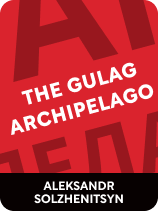

This article is an excerpt from the Shortform book guide to "The Gulag Archipelago" by Aleksandr Solzhenitsyn. Shortform has the world's best summaries and analyses of books you should be reading.
Like this article? Sign up for a free trial here.
What were Soviet prison labor camps like? Why was The Gulag Archipelago so courageous and impactful? What lessons does it hold for us today?
The Gulag Archipelago by Aleksandr Solzhenitsyn describes life in Soviet prison labor camps from the late 1910s to the mid-50s. It exposed human rights abuses by the Soviet Union, counteracting decades of propaganda. Today, it acts as a warning of how governments can use violence, paranoia, and repression to control and exploit their citizens.
Keep reading for an overview of this important book and an exercise you can use to apply Solzhenitsyn’s lessons to the modern day.
The Gulag Archipelago by Aleksandr Solzhenitsyn
In The Gulag Archipelago by Aleksandr Solzhenitsyn, the central argument is that the gulag system was a tool of mass violence, exploitation, and state-sanctioned murder. Despite what the Soviet government claimed, it didn’t provide any benefit to society and it wasn’t rehabilitative for prisoners. It was a way for the government to consolidate power and keep the people in line. Solzhenitsyn makes this argument through the following points:
- The gulags served as death camps, physically and psychologically destroying prisoners over time.
- The state brainwashed its citizens into accepting their own oppression.
- The state conditioned its citizens not to protect or care about one another.
- The state conditioned the authority figures who ran the camps to engage in abusive behavior.
- Attempts by prisoners to protest or change their conditions usually failed.
- Openly discussing the camps would counteract the state’s conditioning and hopefully lead to concrete change in the future.
We’ll explore each of these points in detail while also considering the book’s historical context and comparing Solzhenitsyn’s account to the treatment of prisoners worldwide today.
The Gulag as a Death Camp
Much of The Gulag Archipelago is dedicated to describing just how poorly Soviet prisoners were treated, to the extent that Solzhenitsyn repeatedly draws comparisons between the gulag system and the execution camps operated by the Nazis in World War II. He argues that, although the gulag system wasn’t a tool of genocide in the traditional sense—it wasn’t intended to wipe out a specific national or ethnic group—it still operated as a system of state-sanctioned murder, moving supposed criminals out of the public eye and exploiting them for labor as much as possible before killing them.
On the rare occasions when the gulag system was discussed in public, it was framed as rehabilitative. Prisoners would enter as criminals or “parasites,” labor to provide a useful service to society, and exit as productive workers. However, as Solzhenitsyn points out, the prison system wasn’t designed to facilitate reintegration back into society. Terms were so long and the work so brutal that most prisoners exited with their health totally destroyed and having lost touch with anyone on the outside. In addition, release from prison wasn’t unconditional, as most prisoners were released into exile and ordered, on threat of re-imprisonment, never to return to the cities where they had previously lived and worked.
Forced Labor
The vast majority of gulag prisoners spent their terms doing “general labor” as miners or loggers in remote parts of Siberia. The camps’ designers themselves acknowledged the brutal nature of this work and that many prisoners died on the job. According to Solzhenitsyn, gulag administrators believed that prisoners were only useful to the state in the first three months. Beyond that, labor and mistreatment would have taken too much of a toll, and the best thing was for them to die quickly.
In addition to the inherent physical demands of mining and logging, prisoners worked 12- or 14-hour shifts, were poorly fed and clothed, and never had adequate shelter. They received no formal training in their work and had limited access to tools. Solzhenitsyn also points out that they were, naturally, unmotivated—a prisoner’s survival could depend on their ability to avoid working as much as possible, conserving their energy to avoid burning through the few calories they were given each day. As a result, the camps often operated at a loss, barely justifying the cost of housing and feeding (however poorly) the prisoners in the first place.
Physical Abuse and Neglect
Physical and sexual abuse were part of everyday life in the camps. Guards regularly punished prisoners—for real or imagined infractions—by beating them, taking away their clothing or personal possessions, depriving them of sleep, or keeping them in solitary confinement. Solzhenitsyn notes that, in many prisons, the living quarters had no latrine. Prisoners would have to wait for the guards to accompany them outside to relieve themselves, often only once a day, and this privilege could be revoked as a punishment.
Sexual violence was widespread in the camps, especially for female prisoners or children (from the mid-1930s on, children over the age of 12 could be tried as adults, and Solzhenitsyn claims that thousands served terms in gulags throughout the ’40s-60s). Prisoners were harassed at random by their fellow prisoners and forced into sexual relationships with guards, either in exchange for better treatment or on threat of being assigned to worse labor conditions.
Even when the prison administration wasn’t actively hurting the prisoners, it neglected them—prisoners were regularly denied medical treatment and forced to keep laboring until they were physically incapable of doing so. Those who survived illnesses often suffered, for the rest of their lives, from the lingering effects of malnutrition and permanent damage to their respiratory and gastrointestinal systems.
Length of Terms
It was common for prisoners in the gulag to serve 10- or 25-year terms, regardless of the severity of the offense. Children were generally given three to five years, and Solzhenitsyn’s own eight-year sentence was on the lower end of sentences for anti-Soviet activity. In addition, prisoners often had their sentences extended as a punishment by the camp guards. These extensions were made without a new conviction or investigation process. Rather than taking on additional months or years, prisoners would have their sentence reset, so that they would have to begin serving their 10 or 25 years again from that point forward—regardless of how much time they’d already served.
Exile
Exile was a continuation of prison, just with slightly more freedom of movement. Solzhenitsyn notes that ex-prisoners’ way of life was unstable, since they could be forced by police order or the whims of State Security to move to a different community. Some fled exile and moved back to other parts of the USSR, but they had to remain in hiding or else risk being returned to prison.
Indoctrination
Though the conditions Solzhenitsyn describes were obviously inhumane, they were rarely discussed in public—let alone protested—prior to the publication of Solzhenitsyn’s first novel about the camps in 1962. Solzhenitsyn argues that this silence and the extent and brutality of the gulag system itself was made possible by the near-total control the Soviet government had over its citizens. The government kept people largely in the dark about how it operated, forced them to stick to state-approved narratives of history and pop culture, severely limited communication with the outside world, and criminalized any expressions of doubt or dissidence.
Secrecy
Solzhenitsyn writes that there were no public records of how many people were in the camps, for what crimes, for how long, or in what conditions prisoners were held. When the news or state-sponsored literature referenced the prisons, they portrayed them in exclusively positive terms. Any attempts to question this official narrative would be construed as anti-Soviet activity, itself a crime. Arrests and sentencing were conducted largely in secret. Solzhenitsyn argues that the secrecy with which criminal investigations were conducted worked to terrorize both prisoners and free citizens.
A Powerful Propaganda Machine
From the 1930s on, the Soviet Union had an extremely robust and powerful propaganda system, exerting near-total control over how the government was depicted in the news, radio and television, works of literary fiction, and in education. Historical events that threatened to embarrass the government were covered up, while successes were exaggerated.
Historical Revisionism
The government continually revised official histories, erasing past events or figures in order to serve current political needs. The purges of the 1930s, in which Stalin had dozens of his political rivals removed from power and scrubbed from the historical record, were the most famous example of this practice.
Mislabeling
Another aspect of the propaganda system was the widespread use of euphemism or deliberate mislabeling to obscure the realities of mass deaths or human rights abuses. For example, when public news media reported on the widespread use of prison labor, it often called prisoners “volunteers” and downplayed the physically demanding nature of their work. Mislabeling could also be used to demonize prisoners, thus discouraging people from sympathizing with them.
Xenophobia
Another way the government could indoctrinate its citizens was by setting up a kind of us-versus-them mentality, wherein the Soviet Union was the bastion of morality and strength and had to be defended unquestioningly against other, more corrupt nations.
Because this conflict was positioned as a matter of ideology, the Soviet government limited cultural exchange between the West and the East. This xenophobia provided the basis for Solzhenitsyn’s persecution after the publication of his first novel—he was deemed a national security risk.
Having gone out of its way to make the outside world seem unfamiliar and threatening, the Soviet Union could then wield deportation as a punishment. Those deported would have no hope of communicating with their friends and family back home. Solzhenitsyn notes that, when he was awarded the Nobel Prize in 1970, he was too afraid to leave the country to claim it.
Social Alienation
According to Solzhenitsyn, another way the Soviet Union could control its citizens was via social alienation, or conditioning them not to care about or connect with each other, which worked to repress dissident movements. The legal and prison systems discouraged feelings of empathy while encouraging feelings of instability and fear. There was no logic to who got arrested or punished and who didn’t, so citizens in and outside the camps could only protect themselves by informing on, stealing from, and violently attacking one another. They became wary of offering aid to someone in need and didn’t feel confident enough in other people to try to band together to stand up to their oppressors.
Alienation in the Free World
Solzhenitsyn writes that State Security constantly recruited informers from among the general population. Officials persuaded citizens to turn against their friends and neighbors through appeals to their patriotism, offers of material rewards, or—in the method Solzhenitsyn claims was most common—threats.
Though not everyone became an informer, the popularity of this method further encouraged citizens to mistrust each other—anyone you met could be an informer. In addition, if someone you became close to was later arrested, your association would reflect badly on you. Therefore, it was best practice to trust no one.
Soviet citizens were also under pressure to break off certain relationships in order to prove their loyalty to the state. Failure to renounce your association with someone who’d been imprisoned was considered anti-Soviet activity.
Alienation in the Gulag
Solzhenitsyn writes that the prisons were deliberately constructed to make it difficult or impossible for a prisoner to act out of anything but self-interest.
Hierarchies in the gulag also contributed to the alienation. An entire class of prisoners managed to avoid general labor by emphasizing skills they’d acquired outside of prison, such as mathematics, military experience, or administrative work. Their more privileged positions entitled them to less crowded housing and the first pick of food, which allowed them to take more than their fair share. Some were even given the authority to determine how well other prisoners were treated.
How Power Corrupts
While much of The Gulag Archipelago focuses on detailing the abuse prisoners suffered at the hands of low-level state representatives—the police, State Security officers, and camp guards—Solzhenitsyn also stresses that these representatives were themselves victims of indoctrination and social alienation. While he doesn’t excuse their actions, he argues that they were under incredible pressure from the state to participate in violence and that most acted out of fear of their leaders, the desire for safety, and the need to conform.
Desensitizing Recruits
Soviet propaganda depicted State Security as the defenders of the people and the righteous arm of the state, rooting out evil. Once they joined, it was easy for the power they wielded to go to their heads. Representatives of State Security and the police, no matter how young or inexperienced, were treated with deference by all members of society.
These recruits were quickly exposed to the kinds of abuses they were expected to participate in. Compliance showed loyalty, while refusal or squeamishness was mocked or punished.
Solzhenitsyn’s Reflections
Solzhenitsyn himself nearly became a security officer, and while he ultimately refused on moral grounds, he admits that he behaved nearly as badly as the average camp guard once he was an officer in the Red Army. He was encouraged to mistreat the men under his command, and, even after his arrest, he failed to regard his fellow prisoners as equals. Only after years of imprisonment did he begin to regret his actions. He claims that he behaved so cruelly not because it was necessary or even because he enjoyed it but because it was expected of him.
The Futility of Resistance
Throughout the book, Solzhenitsyn emphasizes that the worst aspect of imprisonment was not the brutal conditions or mistreatment—but its inherent hopelessness. Prisoners’ lives weren’t valued, and there were no avenues for early release or reconsideration of a case. The only thing prisoners could focus on was survival, and this, again, often required them to steal from and abuse others.
Attempts at protest usually failed, either because the camp guards didn’t care about the prisoners’ well-being or because the prisoners had no public forum in which to make their grievances known. The only methods of resistance that did have any effect were work strikes or outright violent takeovers of the camp by prisoners. However, such protests eventually collapsed.
According to Solzhenitsyn, what would have made the biggest difference for prisoners in these cases was some form of transparency. If free citizens knew the extent of the abuses taking place in prison and the prisoners could count on their attempts at protest being recognized and publicized on the outside, they might have been able to work together to demand change.
Transparency and the Future of the Gulag System
Solzhenitsyn ends The Gulag Archipelago with a call for other accounts of the camps to be published—not state-sanctioned narratives, but personal accounts that might supplement or complicate his own work by giving more accurate numbers or a more complete picture of conditions in various camps. Wrapping up his critique of the Soviet government as an oppressive and authoritarian institution, Solzhenitsyn doesn’t propose specific political changes (though he hints several times that he believes that the camp system ought to be abolished), but instead appeals to the reader to recognize the government’s corruption and to seek out alternative histories from ordinary citizens.
Solzhenitsyn says he hoped to start a trend of public criticism of the government in literature, and that he believed that open communication between citizens would create the conditions for more concrete forms of resistance.
Exercise: Apply Solzhenitsyn to the Modern Day
The Gulag Archipelago, as a history and a critique, was highly specific to the Soviet Union and its citizens. Even so, the book is widely read today and has been used as an educational tool for discussing issues such as censorship, political repression, and human rights abuses in prison. Proponents of the book argue that it doesn’t just illuminate the past, but can act as a warning about the future.
- What parallels, if any, do you see between Solzhenitsyn’s depiction of the Soviet Union and your own country? If these two governments are more different than alike, what do you think are the key differences?
- Do Solzhenitsyn’s descriptions of the gulag system resemble the prison system in your own country? Why or why not?
- What do you think the goals of your country’s prison system are, compared to Solzhenitsyn’s claim that the gulag was a tool of control and exploitation?

———End of Preview———
Like what you just read? Read the rest of the world's best book summary and analysis of Aleksandr Solzhenitsyn's "The Gulag Archipelago" at Shortform.
Here's what you'll find in our full The Gulag Archipelago summary:
- A book that was banned for exposing human rights abuses to the world
- A work of historical nonfiction that describes life in Soviet prison labor camps
- How the Soviet government used violence, paranoia, and repression to control their citizens






